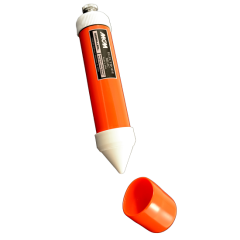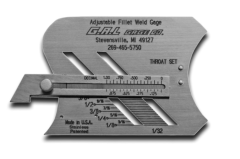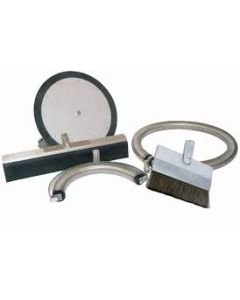Model PCR Polarization Cell Replacement by Dairyland Electrical
The PCR is a solid-state device designed to simultaneously provide DC decoupling and AC continuity / grounding when used with cathodically protected structures, such as pipelines, tanks, grounding systems, and cable casings. The PCR has very high AC fault current and lightning surge current ratings. With a higher blocking voltage than polarization cells, the PCR eliminates the need for placing devices in series, making it the most ideal isolation and grounding product for cathodically protected structures. In addition to out-performing polarization cells, the PCR also surpasses metal oxide varistors and gapped arresters, clamping lightning-caused over-voltages to the lowest possible levels.
Features & Characteristics
- Range of AC Fault Ratings
- Higher Blocking Voltage than Polarization Cells
- UL and C-UL Listed for Grounding Electrical Equipment
- UL, C-UL Listed for Class I, Division 2 Locations
- Certified by UL/Demko for Meeting ATEX Directive for Zone 2; CE Marked
- Available in Submersible Version

Dairyland's Zone 2 product lines (PCR, SSD and OVP2) have achieved IECEx certification.
 Specifications
Specifications
Threshold Voltage
-3/+1V (standard)
-2/+2V (optional)
Other voltages optional
AC Steady-State Current (amperes – rms) 60 Hz
45A (standard)
80A (optional)AC Steady-State Current (amperes – rms) 50 Hz
40A (standard)
70A (optional)Lightning Surge Current
100 kA crest (8 x 20 µs waveform)
| AC Fault Current (amperes – rms) 60 Hz | ||||
| Model | 1 cycle | 3 cycles | 10 cycles | 30 cycles |
| PCR-3.7KA PC-5KA PCR-10KA PCR-15KA |
6,500 8,800 20,000 35,000 |
5,000 6,800 15,000 27,000 |
4,200 5,700 12,000 21,000 |
3,700 5,000 10,000 15,000 |
| AC Fault Current (amperes – rms) 50 Hz | ||||
| Model | 1 cycle | 3 cycles | 10 cycles | 30 cycles |
| PCR-3.5KA PC-5KA PCR-9KA PCR-14KA |
6,100 8,800 19,000 33,000 |
4,700 6,800 14,000 25,000 |
3,900 5,700 11,000 19,000 |
3,500 5,000 9,000 14,000 |
Environmental rating:
NEMA 4X (standard)
NEMA 6P (optional)Hazardous (classified) areas:
Per NEC, CSA: Class I, Division 1 & 2, Groups A, B, C, D
Per EN50021: Zone 2
Third-party listings and approvals:
Underwriter’s Laboratories (UL)
Underwriter’s Laboratories - Canada (C-UL)
CE MarkDimensions & installation
See PCR drawings in pdf format
Technical Comparisons
Liquid-filled Polarization Cell
The polarization cell is an electrochemical switch comprised of pairs of stainless steel or nickel plates immersed in a solution of potassium hydroxide. It responds to DC current by polarizing the plates and reducing the flow of DC current. This occurs up to the threshold of about 1.2V, after which it effectively becomes a dead short. AC current can pass through the device. The electrolyte usually has an oil film on the top to prevent the evaporation. This electrolyte is a hazardous material, with issues of safety, disposal, and environmental concerns. Regular maintenance of the fluid level is needed, especially under conditions where high AC steady-state induced current is present, which can cause the fluid level to be reduced. Fluid level must be maintained to provide the nameplated AC fault current rating, otherwise the surface area for conduction is reduced. On some interval, the fluid is replaced with new electrolyte.
Dairyland PCR
The PCR is a solid-state device which provides DC isolation and AC grounding, up to a threshold of about 3V. It has low AC impedance, allowing induced AC current to be shunted to ground, while providing a high impedance to DC current flow. The solid-state design results in very consistent device characteristics. The device was introduced in 1994 and is used on a wide-spread basis as a replacement for polarization cells. An extensive user base has applied the PCR to pipeline systems, tanks, power cable casings, and separation of grounding systems, for AC grounding and DC isolation of cathodically protected structures. Applications include AC mitigation, lightning over-voltage protection, AC fault conduction, stray current blocking, and grounding electrical equipment that are tied to CP systems. On this last application, the PCR is the only UL listed device for providing an effective grounding path for electrical grounding as required per NEC section 250. Any PCR user is reference for DEI. There have been no reported failures of a PCR for any reason.
Comparison of Polarization Cells to Dairyland PCR
DC leakage current
DC leakage current through the polarization cell is typically 1 mA to about 40 mA, while blocking 0.5V to 1.5V, respectively. This represents the amount of cathodic protection current that will be allowed to leave the pipeline through the device. Beyond about 1.2V, the polarization cell conducts heavily.The PCR leakage current for the same voltage range as above is about 0.005 mA to 0.5 mA. It represents a reduction in leakage current to approximately 1/100th of that of a polarization cell, keeping the cathodic protection system current requirements minimized.
Lightning surge current rating:
PCR: 100,000A crest (8x20 microsecond waveform)
Polarization cell: no published valueAC fault current ratings:
PCR: Various, stated at 1, 3, 10, 30 cycles for each rating
Polarization cell: Various, 30 cycle ratingBlocking voltage:
PCR: 3V
Polarization cell: 1.2V typ.
The polarization cell is sometimes arranged with two or more in series to achieve a higher blocking level. Our solid state approach never requires this.Failure mode:
PCR: Fail-safe; the device will always fail as a dead short
Polarization cell: fails openNeither device is a one-shot device. The PCR can see an unlimited number of operations within its rating. Any failure is non-eventful, and the unit can be easily factory repaired and returned. There have been no failures in the history of the product. The “fail-safe” approach is a significant safety issue, protecting workers and equipment.
Hazardous electrolytes:
PCR: none
Polarization cell: Potassium hydroxideMaintenance requirements:
PCR: none
Polarization cell: regular fluid checks. Occasional fluid replacement. Eventual disposal of electrolyte.The cost of maintenance over the life of the polarization cell, coupled with the cost of safety matters, liability, environmental damage, and decommissioning, has driven a significant number of past users of polarization cells to replace them with PCRs. This is evident at most major power utilities, and a vast number of gas and liquid pipeline systems. Many major consulting engineers now specify our solid-state devices for DC isolation and AC grounding.
Third-party listing:
PCR: UL and C-UL listed as an “effective grounding path,” and can be installed in grounding conductors of electrical equipment. Also listed for hazardous locations: Class I, Division 2.
Polarization cell: none. There are actually no other known devices that are third-party listed in this area.
Comparison of Dairyland PCR to gapped arresters
Arrester:
Typical terms: gas tube arrester, spark-gap arrester, surge diverterReaction:
If the voltage across the gap gets high enough, an arc bridges the two electrodes, establishing a current path. From typical data sheets, it takes an AC or DC voltage of many hundreds to about one thousand volts to flash over, and during lightning conditions, a voltage of about 800V to several thousand volts. The arrester can usually carry 30,000 to 100,000A of lightning surge current (this is the peak value of an 8 x 20 microsecond waveform, which is the industry standard waveform for testing for lightning conditions). Manufacturers do not usually publish AC fault current data, as a gapped arrester cannot carry AC fault current for any significant length of time before failure would occur. The device cannot be used to provide induced AC voltage mitigation, as the device is a permanent open circuit. Failure mode is that the device remains a permanent open, with the electrodes burned back. The device then provides limited or no further over-voltage protection for the joint or structure. The voltage allowed on the structure can then rise to high levels.Dairyland PCR:
The PCR will handle 100,000A of lightning surge current (8 x 20 microsecond waveform.) The device goes into conduction at a much lower voltage than a gapped arrester, keeping the voltage across the insulated flange to a low value. For steady-state conditions, the PCR goes into conduction at about 3V. For lightning surge conditions, the voltage across the PCR would be about 100V. The voltage allowed across a gapped arrester, in comparison, will reach unsafe levels.No arcing occurs within the PCR - it uses large solid-state components for conduction. Notably, the PCR has the ability and ratings to handle AC fault current, with published rating data. No other product has any significant AC fault rating. During any AC fault condition, the PCR would have less than 10V across it. Devices such as gapped arresters do not have published AC fault ratings as they are not intended for such service, yet AC conditions on pipelines are common.
AC mitigation is performed by the PCR, since it is a low impedance to AC current, but a high impedance to DC current from the CP system. It collapses induced AC voltage down to a low level. This function is not available on a gapped arrester.
When protecting insulated joints, many manufacturers of insulated joint kits do not publish satisfactory voltage withstand data such that customers can consider if their protective device can adequately protect the joint. With our known, low threshold voltage, the PCR will provide the best protection for insulated joints or any other connection points where it is applied.
Another very important issue is regarding the design of the PCR, which is considered “fail-safe.” The PCR, if exposed to values beyond our already high ratings, will always fail in the shorted mode (fail as a dead-short). This assures that over-voltages will be clamped to the lowest levels, and if current beyond our ratings is present, the device will safely and non-eventfully fail, bonding the two points together for safety. A gapped arrester has an open gap, which will always remain an open gap. If the arrester were to fail, it would be as an open circuit.
Regarding independent product approvals, DEI has the most extensive approvals of any company. The PCR is UL listed as an “effective grounding path,” so that it can be used for motor operated valve isolation in grounding leads, or other grounding conductor applications. It also is UL listed for Class I, Division 2 hazardous locations.
Summary of PCR benefits over arresters:
- The PCR has a much lower threshold voltage.
- The PCR can handle AC fault current of significant values.
- The PCR clamps over-voltages to much lower levels than any MOV or gapped arrester.
- The PCR is a fail-safe device.
- The PCR has known, fixed parameters.
- The PCR is third-party listed to applicable US standards.






